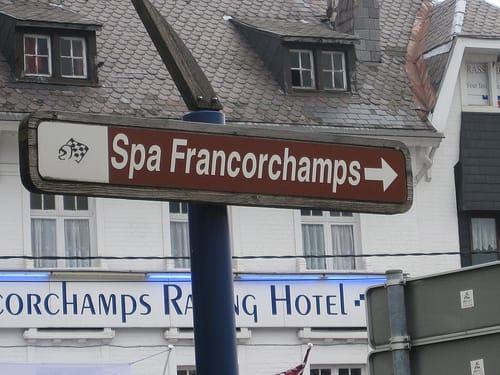
F1weekly podcast number 522
Motorsports Mondial with and Nasir Hameed and
Lucien Byfieldt’s Historical F1 segment.
The Formula One World Championship restarts with one of the classic races on the calendar, the Belgian Grand Prix, held at the Spa-Francorchamps circuit: a 7.004km rollercoaster loop through the hills and forests of the Ardennes area. Over 70% of the circuit is taken at maximum throttle, making it a stiff challenge for drivers, but particularly for engines that need to deliver good top end power, driveability and responsiveness to negotiate the fast, flowing corners such as the famed Eau Rouge and Blanchimont and the tight Bus Stop chicane and La Source hairpin.
Belgian Grand Prix facts and figures
– Spa is longest circuit on the calendar by some margin – a lap is 7.004km; the next longest is Silverstone at 5.891km. Over 70% of the track is taken at full throttle, which equates to 4.903km – longer than the entire Circuit de Catalunya!
– Over one lap the engine will have a total wide open throttle time of 43secs. There are two principle ‘straights’ – the first from Turn One, the La Source hairpin, through Eau Rouge and up to Les Combes on the Kemmel Straight. The RS27 engine will be at maximum revs (18,000rpm) for 23secs on this section. The second long straight is 23secs from Stavelot to the Bus Stop chicane where the RS27 engine will be at max revs for 20secs
– The track goes downhill from La Source before climbing 80m through Eau Rouge to Les Combes. This is particularly tough for the RS27 engine as there are a lot of lateral G-forces, approx +3g to -4g and then 5g to -3g going over the crest of the hill. The pressure can affect the flow of lubricants through the hydraulic and lubricant systems
– The La Source hairpin is the slowest part of the track where drivers drop to just 70kph and 8,700rpm. However the long straight afterwards requires the engine to pick up very quickly so Renault Sport F1 engineers create maps that enable the drivers to have smooth, but rapid, acceleration on the long straight
– The length of the circuit and its geographical location in the forest-clad hills means there are often microclimates over the course of a lap; it could be raining in one location but dry in another. Engine maps are therefore created to be a compromise to give as much flexibility as possible. Ironically the ban on changing engine maps between qualifying and the race is likely to have very little impact here as conditions can change so quickly
Mark Webber:
The Belgian Grand Prix is one of the toughest races of the year, but also one of the most enjoyable as it’s such a challenge to put together a perfect lap. You’ll tackle every sort of corner and weather condition over the weekend, which means you need to be on top of your game every single session. As a result you need to know that the engine is reliable and driveable so you can concentrate on getting the most from yourself. Top end power needs to be there so you can attack corners like Eau Rouge and Stavelot that you’ll be taking in top gear at maximum revs but responsiveness is also crucial to get the pick up out the slower corners such as the Bus Stop chicane and La Source. Good engine mapping and management can make a huge difference over such a long lap.’
Rémi Taffin:
Spa-Francorchamps is a circuit that gives us the ‘most’ of everything. It’s the longest, the most changeable weather conditions, but from an engineer’s perspective it’s the most enjoyable as it’s so much of a challenge. The driver will encounter every sort of corner possible so we, as engineers, have to consider how to get the RS27 to perform over all levels of torque and revs.
We need the engine to deliver a smooth power curve through the flowing corners like Blanchimont and Eau Rouge but also to be responsive out of the slower hairpins and chicanes. There are also two notable braking zones: the first corner hairpin, made more difficult by being downhill, and then the Bus Stop where the car brakes from 310kph to just 75kph – putting the engine internals under huge pressure. The long straights and long wide open throttle times also demand a good 7th gear ratio, essential for a good lap time, so you can see we need to be completely on top of every area of performance.
Getting the mapping right, while also allowing enough flexibility to deal with the changeable weather, means it’s one of the circuits we spend the most time on in the dyno; approx 4.5 hours and a further five hours calibration. In fact we use Spa as a control circuit to test an engine’s reliability as it puts so much strain on the internal parts. With such huge demands exerted, we’ll be using fresh engines for this race with each of our partners to give them as much power as possible.
Renault Sport F1 also observed the two week FOTA shutdown period. The Viry site was closed the middle week between the Hungarian and Belgian Grands Prix, with the 250 staff taking a further one week either before or after the closure.
Renault engines have won at the track on five occasions, the first coming in 1983 with Alain Prost (Renault). Ayrton Senna (Lotus-Renault) took the win in 1985 before Damon Hill won for Williams on consecutive years in 1993 and 1994 and Michael Schumacher in 1995 with Benetton.
Red Bull Racing-Renault’s Mark Webber took pole position last year and finished second in the race.
[audio:http://www.podtrac.com/pts/redirect.mp3/mp3.f1weekly.com/podcasts/08-24-11f1weekly522.mp3]
